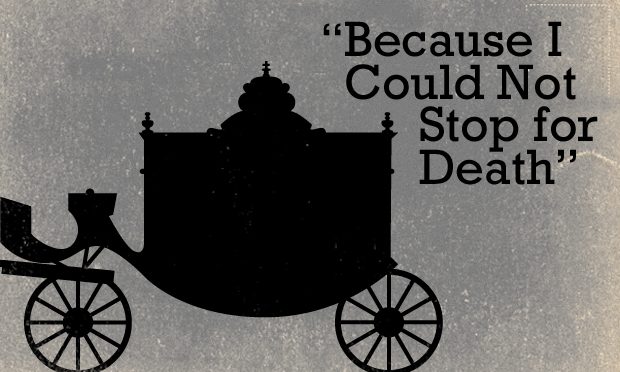
Because I Could Not Stop For Death is one of the most celebrated and anthologized poems of Emily Dickinson. The narrator says that she couldn't go gentle towards death, but death was kind enough to approach her. In the carriage (coach of their journey) her sole companions were death and immortality.
They drove slowly and gently . Death, the driver of the carriage, was not at all in haste. The speaker had given up everything including her labour and her leisure as well. She did it because death was not at all intimidating in appearance. Death looked like humble and gentle, in fact acceptable to the narrator.
In the course of their journey, they passed a school where
children were playing in enthusiasm . They also passed the lovely fields y gazing
the grains.They
passed the
sun as well, the sun that was setting.
The sun too passed them by leaving chilling dews. narrator had a gown made of gossamer. She also had a scarf around her neck and a soft silky dress.In other words, she was attired like a bride.
They also passed before a House that seemed like a swelling
of the ground. The roof of the House was hardly visible. The wall was in the ground. Centuries
have passed from
that day. Indeed, it was a long journey Yet it seems it has been shorter than a
day. The narrator felt that the carriage in
which she had travelled in the company of death was heading towards Eternity. In other words, it
is only through death that the narrator attains immortality. The poem is highly
significant and remarkable with the distinct use of personification expression
of death. It also
reminds one of Keats' dictum
that death is the meed (reward)
of life.
Death is personified, or described in terms of human characteristics throughout the poem
The 'Thanatotic' impulse is discernible in the poem. Emily Dickinson best known for her eccentric personality and she frequently expressed a fascination to death. thus mortality plays a key role in her verses.
Dickinson's preoccupation with death began at her younger age as well. At the age of 14, she suffered her first major loss when her friend and cousin Sophia Holland died of cancer. being her intimate friend Holland's death send her into such a melancholy spiral that she was sent away to Boston to recover. like this she was too witnessed many of her dear's departure. probably, these series of departures made her to focus on mortality frequently.

No comments:
Post a Comment
looking forward your feedbacks in the comment box.